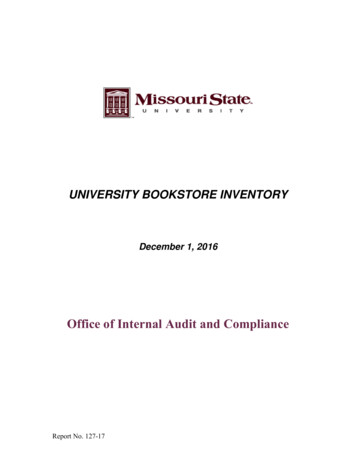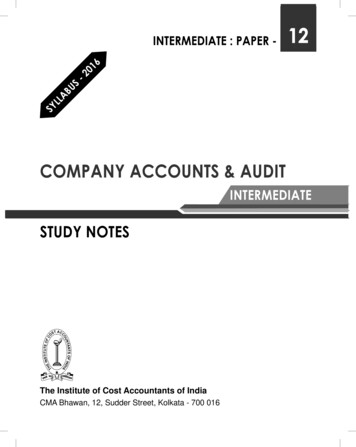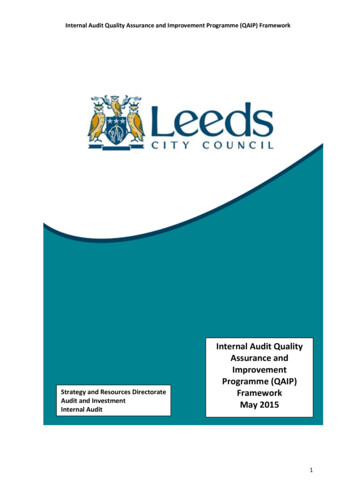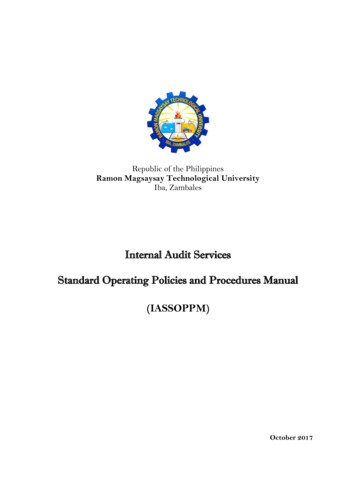
Transcription
UNIVERSITY BOOKSTORE INVENTORYDecember 1, 2016Office of Internal Audit and ComplianceReport No. 127-17
DATE:December 1, 2016TO:Ray Presnell, Springfield Bookstore DirectorFROM:Donna Christian, Director of Internal Audit and ComplianceTami Reed, Senior Internal AuditorCC:Dr. Dee Siscoe, Vice President of Student AffairsClifton M. Smart III, University PresidentUNIVERSITY BOOKSTORE INVENTORYBACKGROUNDOn May 27, 2016, Internal Audit reviewed the annual physical inventory count at the MissouriState Bookstore. The physical inventory on this date was reconciled to the inventory balancesrecorded in the Bookstore’s point of sale system and the University’s accounting system at thefiscal year end of June 30, 2016 for the University’s financial statements. The Bookstore’sinventory balance during the last six years is as follows:FYE June 30,201620152014201320122011Sales (retail) 15,767,532 15,279,233 15,571,547 15,776,401 15,169,936 15,092,110Inventory (cost) 6,190,350 3,948,774 4,007,757 4,735,104 3,864,269 3,698,825The June 30, 2016 inventory balance was considerably higher than previous years because thenew textbooks for fall had been received prior to June 30, 2016.Effective November 14, 2016 the Bookstore replaced their point of sale (POS) system (BookLog)with a new system (Ratex). Internal Audit also performed test counts on the transfer of inventorybalances from the old POS system to Ratex to provide assurances of an accurate transition.The Bookstore continues to be a fiscally successful operation. It has not only been able tocontribute to the direct needs of the students, faculty and staff, but it also financially contributes tothe University’s operating fund through budget transfers.1
OBJECTIVE AND SCOPEThe objective was to review inventory procedures, test the accuracy of the annual physicalinventory count of the Missouri State Bookstore, and test the accuracy of the transfer of inventorybalances from the old POS system to the new Ratex system. The scope of the audit was fiscalyear ended June 30, 2016 for year-end inventory balances, and November 14, 2016 for inventorybalances transferred to the new Ratex system.SUMMARYAgain, a detailed analysis of the Bookstore’s BookLog inventory value and the inventory recordedin the University’s Banner system was completed for June 30, 2016. The BookLog systembalance of 6,190,350 was 238,929 (wholesale cost) higher than the Banner recorded inventoryor an increase of 1.38% of retail sales. Similar to last year, this is the inverse of the typical yearend inventory comparison and did not allow any evaluation of shrinkage. The errors in theBookLog system appear to be the cause. The BookLog system, was replaced with a newprogram, Ratex, effective November 14, 2016. We applaud Bookstore management for makingthe transition to a new system and also applaud Bookstore personnel for the accurate transfer ofinventory balances from the BookLog system to the Ratex system.Included in this report are recommendations addressing the following: Reconciliations between inventory costs in the Banner and Ratex systemDestruction procedures for old, unused gift cardsA review of student accounts receivable policies to ensure complianceA textbook inventory and adoption date analysis for the timely return of textbooksReview of the System Analyst duties for internal control purposesDocumentation of inventory purchasesSincerely,Donna Christian, CPA, CGFMDirector of Internal Audit and ComplianceSenior Internal Auditor: Tami ReedAudit Fieldwork Completed: November 22, 20162
OBSERVATIONS, RECOMMENDATIONS AND MANAGEMENT RESPONSES1. PHYSICAL INVENTORY COUNT AND SHRINKAGEInternal Audit observed and tested the annual physical inventory at the Bookstore. TheBookstore inventory totaled 6,190,350:DepartmentValue (Cost)New TextbooksUsed TextbooksTotal Textbooks Greeting nGreekSouvenirsSchool and Art 9,04122,744Grand Total 6,190,350After completion of the physical inventory, the inventory amounts in the Bookstore’s BookLogsystem were compared to the inventory values recorded in the University’s Banner system forJune 30, 2016. The BookLog system balance of 6,190,350 was 238,929 (wholesale cost)higher than the Banner recorded inventory, or an increase of 1.38% of retail sales. Similar tolast year, this is the inverse of the typical year-end inventory comparison.In the past two years, it has been noted that BookLog randomly assigns an average cost atthe time of sale that does not agree to the cost that was assigned at the time of receiving. Insome cases, the assigned average cost even exceeds the sales price. Consequently, thecost of goods sold is occasionally inflated and results in the Banner inventory balance beingunderstated. For example, a donut with a sales price of 59 cents had an average cost inBookLog at the time of sale of 48.13. In another example the sales price of a used textbookwas 99.50 and the assigned cost at the time of sale was 207.25. Receiving reportsindicate the items were received with the accurate costs but BookLog randomly assignedanother cost.This situation was identified and reported in last year’s audit. The BookLog POS system wasreplaced with Ratex, a new program, effective November 14, 2016. The periodicreconciliations performed by Bookstore personnel have helped to identify the inaccurate costof goods sold amounts calculated by BookLog. These reconciliations should be continuedwith the new point of sale system to ensure accurate inventory costs are recorded.3
RecommendationContinue to perform periodic reconciliations of inventory costs to monitor any differencesbetween the Banner general ledger inventory accounts and the new Ratex system balances.Management ResponseTo ensure the accuracy of the new Ratex system, management will continue to performperiodic reconciliations between the Banner and Ratex inventory accounts. With theimplementation of this new system, management believes that past issues with varying costof goods amounts and inaccuracies are in the past as the store relies on a more accuratesystem.2. TRANSITION TO THE NEW POINT OF SALE SYSTEMWe commend Bookstore management and staff for a smooth and accurate transition from theBookLog POS system to the Ratex system.Our comparison of inventory balances noted that there were 209,948 inventory items with aretail sales price of 3,512,868 in BookLog on the last day in use, and 209,741 inventoryitems with a retail sales price of 3,514,844 in Ratex on the first day in use. This is adifference of only 207 items or 0.09%. The retail value difference was only 1,976 or 0.05%.Bookstore management and staff worked hard during this transition and we applaud theirefforts.3. GIFT CARDSSince a change in Bookstore management in 2012, over 1200 gift cards with a valueexceeding 22,000 have been retained in the Bookstore safe awaiting the determination ofproper disposition. Previous management purchased the gift cards with Bookstore funds, andkept various values of gift cards on hand to distribute to groups and organizations as ameans of advertisement. This manner of advertising was abandoned with new managementand a more controlled advertising method has been implemented.Since these cards have not been utilized in four years and with the implementation of the newpoint of sale system, current Bookstore management has determined it is an appropriate timeto remove the gift cards from the system and the store’s general ledger balance.RecommendationThe gift cards in the safe should be destroyed under independent supervision and a journalentry should be posted to the University’s accounting system to remove the gift card balancefrom the general ledger account.Management ResponseAs per the recommendation, the gift cards that have been stored in the safe the last fouryears will be discarded. This manner of advertising is no longer in place. The balance will beremoved from the general ledger account.4
.4. STUDENT ACCOUNTS RECEIVABLEA policy has been established limiting students to charge up to 500 in merchandise to theiruniversity accounts receivable (AR) at the Bookstore. An exception is made during the firsttwo weeks of each semester to allow students to charge all textbooks without dollarlimitations. After the first two weeks of the semester, textbooks are subjected to the same 500 limitations as other merchandise. Internal Audit reviewed 25 students with excessivecharges to test compliance with the policy. Of the 25 students, 19 students were allowed tocharge purchases in excess of 500 after the exception period. While this matter wasdiscussed in the prior audit of the bookstore, compliance was sometimes difficult due tolimited communication between the University’s accounts receivable system and theBookstore’s old point of sale system, BookLog. The new point of sale system provides someAR monitoring features that should improve policy compliance. Management should alsoreview the established limits in this policy considering the increased costs of textbooks.Additionally, in Spring 2016 the Bookstore established a policy that gaming consoles andaccessories are not to be charged on a student’s AR. This policy is also not always followed.We noted 3 students with charges for gaming consoles since Spring 2016.RecommendationBookstore management should review student AR limitations and establish specific guidancefor exceptions. As these policies are redefined to meet current needs, controls should beestablished within the new point of sale system to ensure these policies are followed.Management ResponseWith the new system Ratex, specific spending limits can be set, and adjusted throughout thesemester if necessary. Bookstore management will work with the Financial ServicesDepartment and establish credit limit guidelines that ensures we can continue to serve ourstudents at the beginning of the semesters with their textbook and supply needs, and at thesame time protect the Bookstore and students from over extending themselves and theircharging privileges.Also, the gaming hardware policy will be reviewed with students who work at the PawPrintsstore, and the new students who are hired to work in that store, to ensure compliance.5. TEXTBOOK SALES TO WHOLESALERSWhile textbook inventory management procedures for dead or obsolete textbooks have beenemphasized over the past years, management needs to continue to improve the processsince the loss in this area continues to increase.Textbook inventory management and control is extremely important in bookstoremanagement. In FY 2016, textbook sales were 10.3 million of the Bookstore’s total 15.8million sales. There are three options for unsold textbooks: 1) return textbooks to the vendorfor a full credit/refund if within time restraints, 2) sell textbooks to wholesale book buyers for adiscounted amount 3) sell textbooks through a Monsoon account (eBay).Our prior report recommended that the Bookstore analyze textbook inventory based upon thetextbook adoption date and ensure textbooks are returned to vendors timely for full credit.While the textbook manager has established some procedures to manage the textbookinventory, regular management of text book inventory is critical to ensure the maximum5
amount of value is received for unsold textbooks. Improvement is not evident in the reportedinformation. As previously reported in FY15, textbooks costing 287,895 were sold towholesale book buyers for 145,059, for a loss of 142,836. In FY16, textbooks costing 308,218 were sold to wholesale book buyers for 124,710, for a loss of 183,508.Recovering some of the costs of excess textbook inventory is definitely better than a totalloss; however, it is important to ensure all textbooks are returned to the publisher or vendorwithin the return timeframe to avoid any loss.RecommendationsWe again recommend the Bookstore establish procedures to continually analyze textbookinventory based on the semester of adoption and ensure textbooks are returned to thevendors on a timely basis for full credit to minimize any overstocking loss.Management ResponseManagement will continue to work on our purchasing and returning procedures to ensureimproved performance in this area. The implementation of Ratex and its built-in tools andfeatures will aid in this effort.6. SUCCESSION PLANNINGBetween December 2015 and May 2016, a new point of sale system for the Bookstore wasplaced out for bid, bids were evaluated, and the new system was selected. The entireprocess was led by the part-time Systems Analyst at the Bookstore. During July 2016, thepart-time Systems Analyst accepted a full time position with another University department tobecome effective August 15, 2016. Because of the implementation of the new point of salesystem, an agreement was made between the employee’s new department and theBookstore that the employee would continue to work at the Bookstore on an as-needed basisuntil implementation of the point of sale system was complete in November 2016.As of December 2016, the Bookstore has not actively sought a replacement for the SystemsAnalyst position. Other employees at the Bookstore have absorbed some of theresponsibilities, such as establishing operators, setting administration settings and otherresponsibilities that comprise some of the internal controls previously established. Because ofsome of the sensitive duties previously performed by the Systems Analyst, an adequatesuccession plan should have been developed to avoid compromising internal controls.RecommendationReview the duties previously held by the System Analyst and determine a succession planthat does not compromise the Bookstore’s established controls.Management ResponseManagement is actively pursuing the employment of a systems analyst either in a part-time orfull-time role.7. INVENTORY PURCHASE DOCUMENTATIONIn May 2016, the Bookstore transferred 2,382 to the Foundation’s Football Special ProjectsFund for 181 t-shirts that were reportedly left over from the coach’s 2015 football camps.These shirts were posted to inventory by the Bookstore at values ranging between 11.696
and 13.49 with no invoice or other documentation to determine these values.Documentation provided to Internal Audit by the football camp indicated the camp paid atmost 5.75 per t-shirt or 1,041. The documentation also shows that 17 more 2XL shirts werepurchased by the bookstore than were on the original camp shirt order.An additional transfer to the Foundation’s Football Special Projects Fund for 4,888 wasinitiated in August 2016, but was stopped before being finalized for lack of adequatedocumentation. This transfer was for 56 t-shirts left over from 2016 football camps andanother 283 shirts that were part of an inadvertent double order placed by the Universityfootball program. Upon detailed review it was determined that the actual cost of the campshirts was 259 and the actual cost paid by the football program’s budget for the remaining283 shirts was 2,123 ( 2,382 total).The transactions between the bookstore and the coach’s football camps appears to violateUniversity Policy G1.02 Conflict of Interest and Financial Disclosure which provides that noemployee shall sell any property to the University in excess of 500 annually unless thetransaction is publically bid and that bid is the lowest received. Additionally, when thebookstore purchases clothing from the University’s athletic department the cost of theclothing should agree with the actual cost paid by the University and the bookstore shouldobtain documentation to support the cost.RecommendationsMaintain adequate documentation to support all inventory purchases, discontinue any futurepurchases from any sports camps or related parties that exceed 500, and if inventory ispurchased from any University athletic program it should be purchased for the actual cost ofthe item.Management ResponseMoving forward, if this type of opportunity arises again, management will follow policy andonly make such purchases after verifying the invoiced costs of those goods from thatdepartment; and the transaction amount is less than 500.8. BOOKSTORE CASH COUNT AND CASH REGISTER CONTROLSOn May 27, 2016, the cash assigned to the Bookstore, including all cash in the safe as wellas all cash in the various drawers at all locations, was counted and verified. The followingwas determined: Total cash counted was 10,000. This agrees to the amount recorded in the University’saccounting records and to the petty cash worksheet maintained by Financial Services. Our review of the cash logs at the Bookstore showed that the prescribed procedures andcontrols are being followed: Cash in drawers is counted by the manager each day and properly recorded intoBookLog. Cash in the safe is counted twice each day (morning and evening) by two differentemployees. Each count is properly recorded in BookLog.Recommendation7
None.8
State Bookstore. The physical inventory on this date was reconciled to the inventory balances recorded in the Bookstore's point of sale system and the University's accounting system at the fiscal year end of June 30, 2016 for the University's financial statements. The Bookstore's inventory balance during the last six years is as follows:











